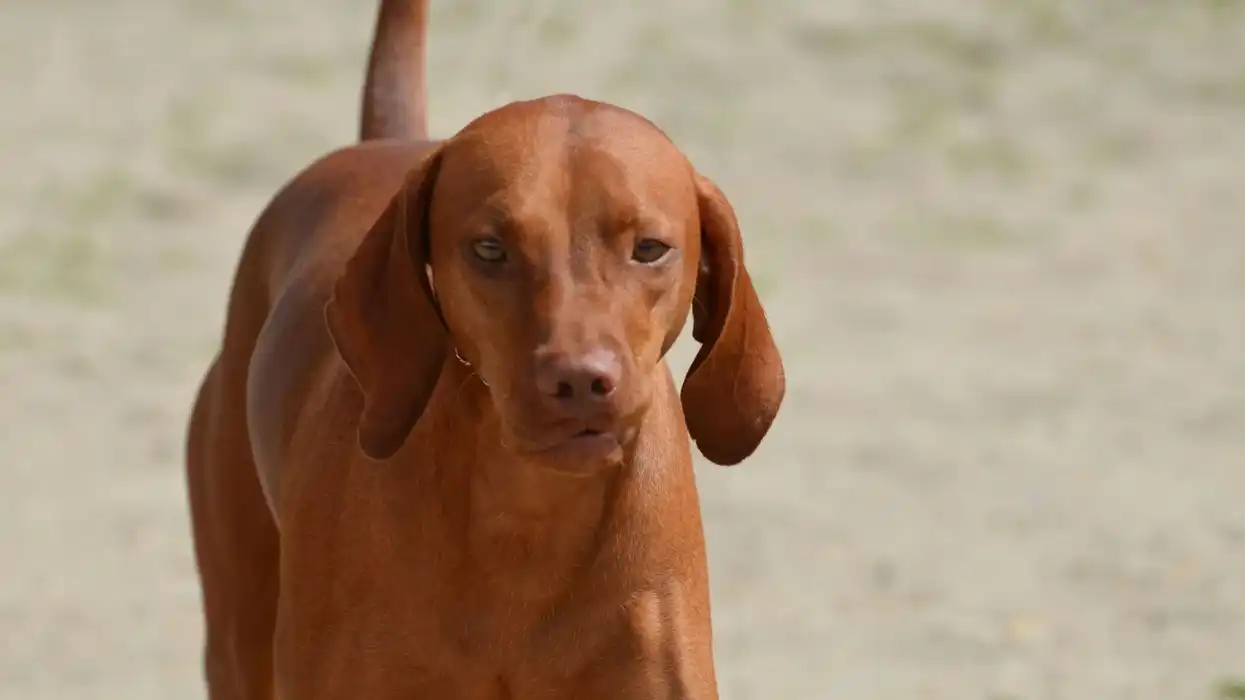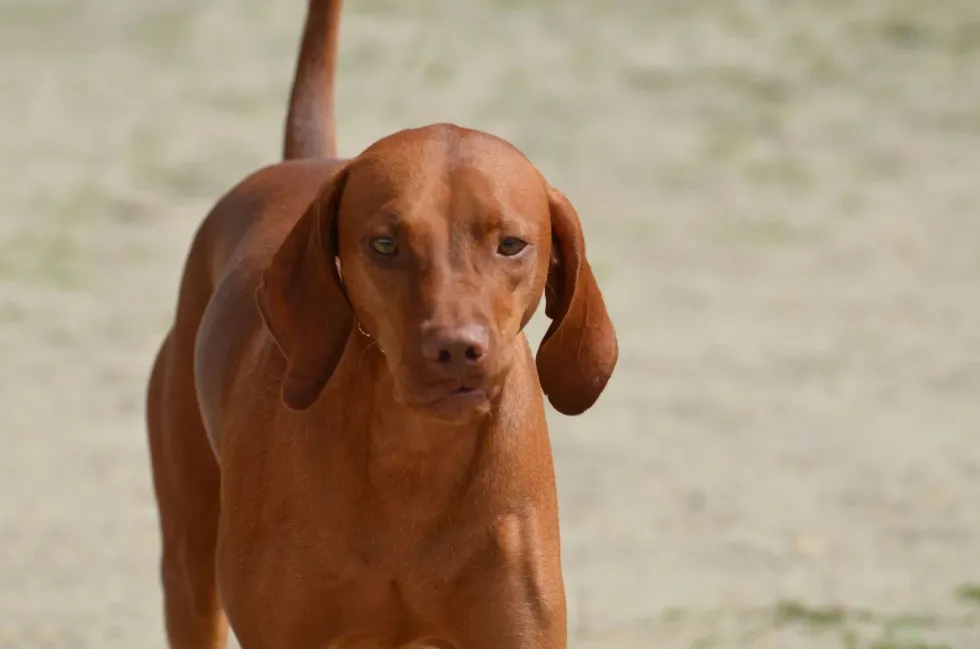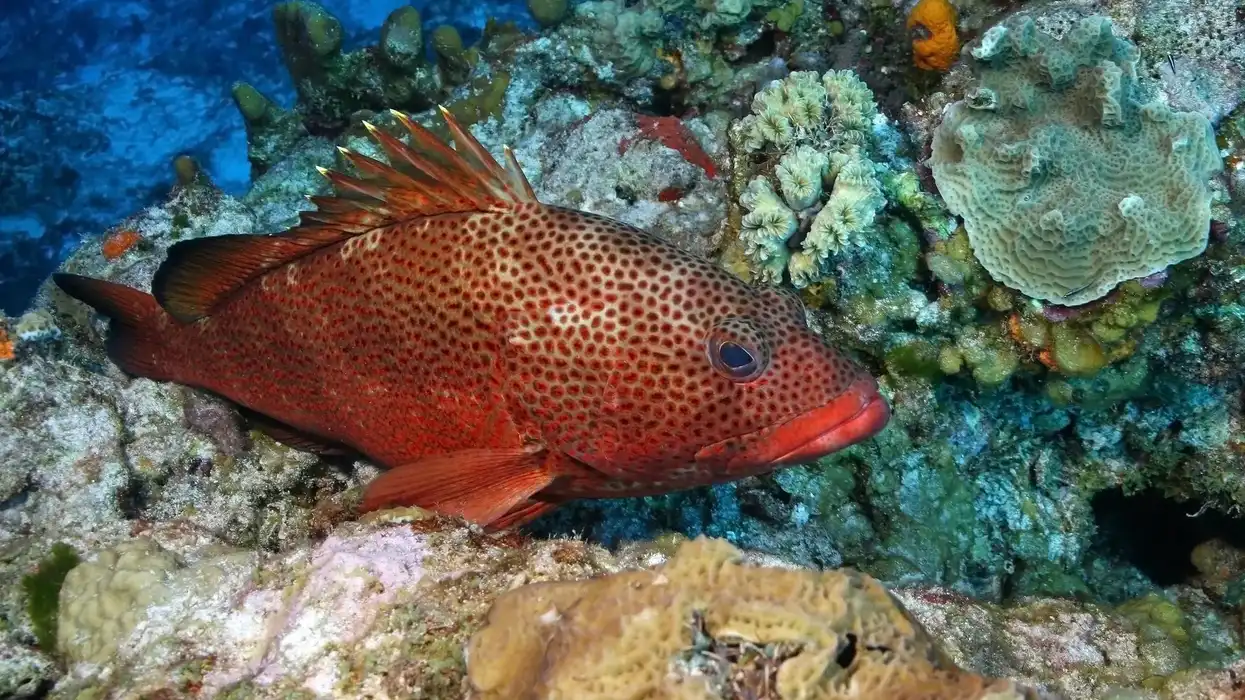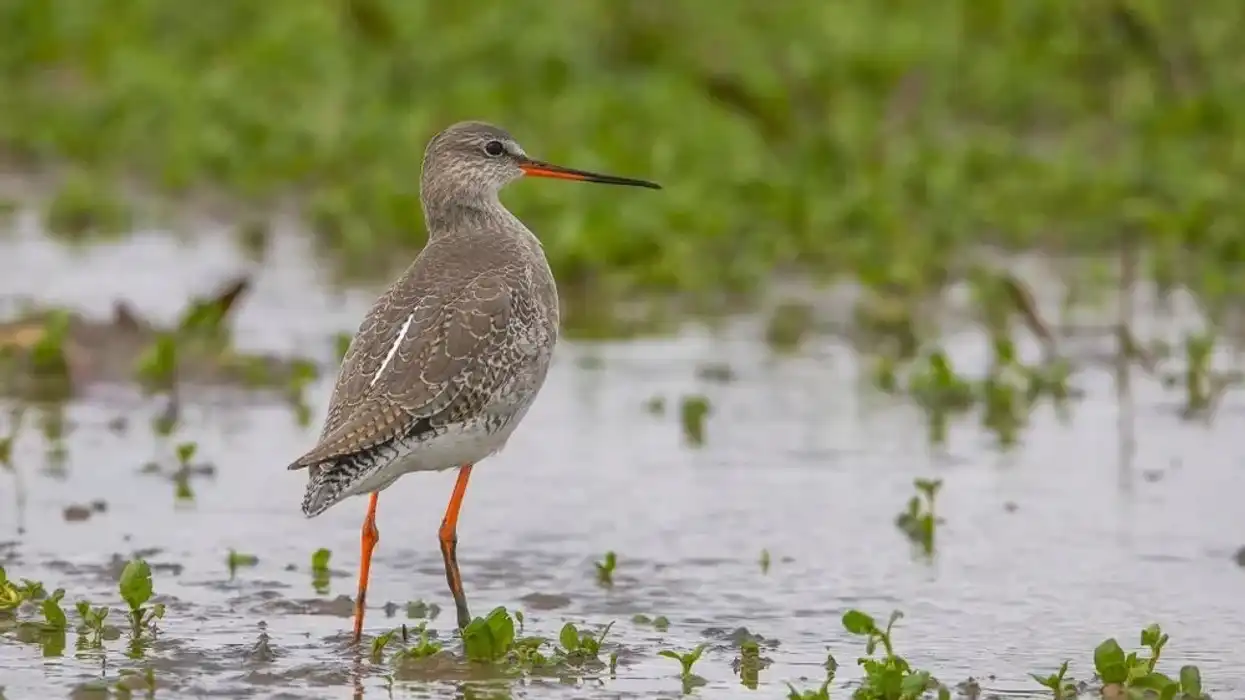Fun Pawsome Redbone Coonhound Facts For Kids

Content
- What type of animal is a redbone coonhound?
- What class of animal does a redbone coonhound belong to?
- How many redbone coonhounds are there in the world?
- Where does a redbone coonhound live?
- What is a redbone coonhound's habitat?
- Who do redbone coonhounds live with?
- How long does a redbone coonhound live?
- How do they reproduce?
- What is their conservation status?
- What do redbone coonhound look like?
- How cute are they?
- How do they communicate?
- How big is a redbone coonhound?
- How fast can a redbone coonhound run?
- How much does a redbone coonhound weigh?
- What are the male and female names of the species?
- What would you call a baby redbone coonhound?
- What do they eat?
- Are they slobbery?
- Would they make a good pet?
- Did you know...
- Characteristics and health issues
- Getting your own redbone coonhound
The redbone coonhound is a medium-sized breed of dog that is known for its striking appearance as a tall, slender hunting dog. These dogs are primarily red in color but in some cases, white shades can be found on their bodies.
These dogs belong to the scenthound variety of dogs like the bloodhound, which was bred with the Red foxhounds to create the redbones.
These coonhounds are active dogs and like to spend their time running around their surroundings and love to be mentally stimulated through various exercise and training methods. As active as they are, they can also be quite lazy! They love the comfort of household furniture and spend a small part of their days lazing around.
As of now, these dogs can be found worldwide in pet stores, online, or with breeders easily and are not on the expensive scale. If you are looking for a fun-loving companion that is pretty to look at, then this dog is the best pick for you!
If you like these true facts about the redbone coonhound, then check out articles about the mini labradoodle and French Brittany.
Redbone Coonhound Interesting Facts
What type of animal is a redbone coonhound?
The redbone coonhound is a dog breed that originated in the United States, specifically in the southern United States. This dog variety was originally a hunting dog that was used to hunt small animals like raccoons, cougars, bears, deer, and other larger game animals.
The origin of this canine comes from Scottish migrants who made then way into the United States and with them, brought red foxhounds with them that were cross-bred with the bloodhound breed group.
Redbond coonhounds were named after an early breeder, Peter Redbone, who was from Tennessee. In 1902, the redbone coonhound became the second coonhound dog to get recognized by the United Kennel Club, and in 2010, was recognized by the American Kennel Club.
What class of animal does a redbone coonhound belong to?
Redbone coonhounds belong to the Mammalia class of animals.
How many redbone coonhounds are there in the world?
The exact population count of this dog breed is unknown. However, going by its popularity and how healthy these dogs are said to be, there is still a long way to go before the population of this hunting dog breed even dwindles.
As a result of this healthy lifestyle, redbone coonhounds are among some of the famous dog breeds that have made their way through households all across the globe and are part of an enticing canine group that can be kept as pets.
Where does a redbone coonhound live?
Redbone coonhounds are not the best adaptability-wise and often struggle to live freely in either cold or warm weather. Their coat is short and smooth and sticks to their body, due to this, the bodies of this hunting dog breed are not well protected.
This thin solid red coat makes these dogs an unsuitable breed for harsh weather in both cold and warm parts of the world.
It is advised to give your redbone coonhounds ample training and exercise to keep their health and weight in check.
What is a redbone coonhound's habitat?
Since redbones have a thing coat of fur they can often fall prey to harsh weather conditions.
Due to this, redbones are more of an indoor dog, but can equally enjoy outdoor conditions too. These dogs are lazy and will spend their time on soft furniture and in the air conditioning.
This lifestyle leads to these breeds being fond of comforts available to them and it is advised to dress them up in an insulating coat or a sweater when you take them out for their daily exercise or training.
Redbones will live comfortably in an apartment or a large house with a backyard. Just remember to walk them regularly to burn all the excess energy that they have stored in their bodies. Their short and easy to brush coat fur allows this breed to live and even sleep outdoors through various terrains.
In short, the redbone coonhound habitat is preferable to whichever country or region they are living in with their owners.
Who do redbone coonhounds live with?
Redbone coonhounds are a friendly breed of dogs and hence, loves to be around their owners. Redbones are a great family dog breed and have a fondness towards children, however, they are quite sensitive, meaning they are a breed that is not suitable for a chaotic household with lots of movements.
Due to this high sensitivity level, the training of these dogs should begin when they are puppies.
Redbone coonhounds can also easily co-exist with other dogs as they are quite fond of them and will spend time playing with other pets.
They have a high tendency to bark or howl which can cause a bit of a problem if you happen to live in apartment complexes and they also have a tendency to chew on things, which can be stopped by proper training, but if left unchecked, can be quite destructive.
How long does a redbone coonhound live?
The average lifespan of the redbone coonhound is estimated between 12-15 years. This lifespan can be extended through various means like maintaining a healthy diet to manage any excess weight and by providing an ample amount of exercise to burn through the high energy that this breed has.
How do they reproduce?
Like most breeds of dogs, the redbone coonhound too reaches sexual maturity by the age of five to six months, mostly as puppies. However, they are bred only after they reach ten months of age.
During the breeding period, both the male and the female are in heat and release pheromones that help in letting the other sex know that mating is possible.
After copulation and successful fertilization, the female will go through a gestation period of 63 days after which she will give birth to a litter of 6-10 adorable puppies.
What is their conservation status?
The redbone coonhound has no special designation under any group on the IUCN Red List and is currently not listed. It is understood that this hound breed has a rather stable population across the globe and is by no means, anywhere close to being in danger of being vulnerable or extinct.
Redbone Coonhound Fun Facts
What do redbone coonhound look like?
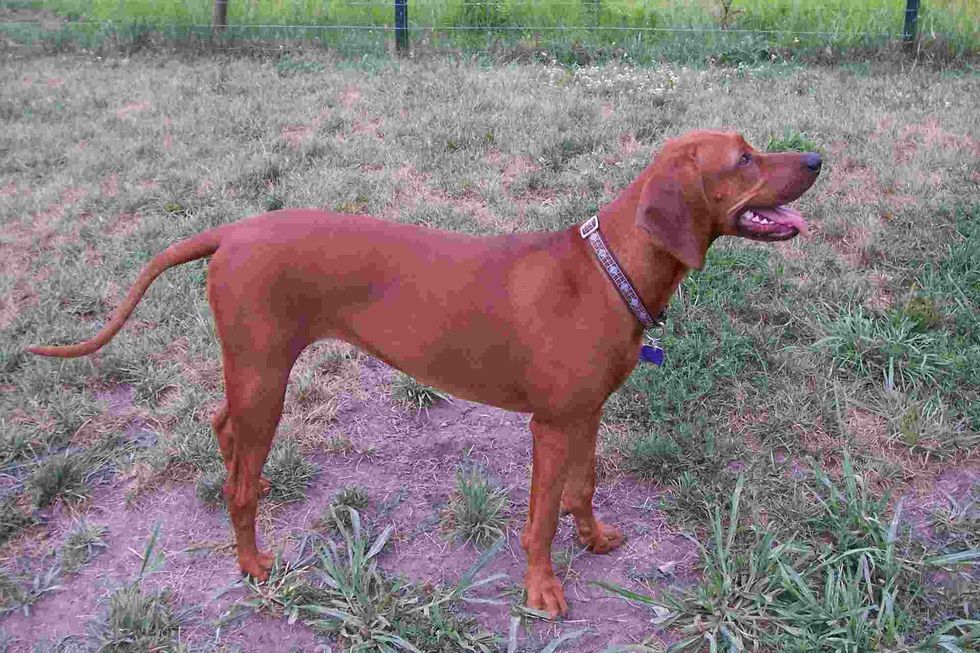
Like most other breeds of hound dogs, the redbone coonhound is a handsome dog breed. These dogs have a rich red coat of fur with a dark muzzle and a small amount of white is visible on the chest and feet of these dogs.
This hound has powerful hind legs that are strong, muscular, and lengthy which helps them in covering large distances when they are used for hunting purposes. Their slender body is topped off with a thin raised tail.
The redbone coonhound temperament is visible through this dogs' bright round eyes that range from hazel to dark brown. The ears are long and silky to touch and curve around right under the jawline.
How cute are they?
The redbone coonhound is absolutely adorable to look at and is often seen as a handsome hound breed. Redbone coonhound puppies are cute to the core and will beat the adult in a cuteness competition!
How do they communicate?
These dogs communicate with each other through visual and auditory methods. They will bark, whine, sniff, lick, and roll to communicate with each other and their owners.
How big is a redbone coonhound?
Redbone coonhounds are medium-sized hunting dogs and adults have a body height that ranges between 21-27 in (53.3-68.5 cm). These dogs are almost three times as big as pugs, which are 9-15 in (22-38 cm) tall.
How fast can a redbone coonhound run?
Redbone coonhounds are agile dogs as they were originally used for hunting purposes. This leads to the belief that these dogs come under fast breeds and can reach high speeds when they track the game that they are hunting.
The exact speed of the redbone coonhound is unknown.
How much does a redbone coonhound weigh?
A healthy adult redbone coonhound reaches a maximum bodyweight of 45-70 lb (20.4-31.7 kg).
What are the male and female names of the species?
Male redbone coonhounds are known simply as dogs and female redbones are known as bitches.
What would you call a baby redbone coonhound?
A redbone coonhound baby has the same name as most dog babies and is known as a puppy.
A redbone coonhound puppy is born in a large litter of 6-10 siblings and is blind until it reaches eight weeks of age. The ears of the puppy open 14-18 days after it is born.
What do they eat?
Redbone coonhounds are medium-sized dogs and hence need to be fed a proper diet that is both nutritious and well-balanced.
The redbone coonhound's diet is one of the most important aspects that need to be controlled as these dogs are enthusiastic eaters and will sometimes overeat. Overeating will affect the body even if your dog goes through its exercise regime every day.
Hence, it is recommended to feed them about two and a half cups of dry dog food in the form of two small meals instead of one large meal.
This controlled diet will help your redbone to achieve a normal height and weight and protect them from the harms of obesity.
Are they slobbery?
Yes, redbone coonhound dogs are excessive droolers and will get their drool all over their surroundings. If you are someone who wants to get this hunting dog but does not entertain the idea of being drenched in the odor of dog drool, then breeds like these are not for you.
These dogs will get their drool all over your clothes and furniture, even leaving being their red fur that they shed.
Would they make a good pet?
Yes! Redbone coonhounds are excellent pets and are among the few breeds that do not have many health issues. It is advised to start your redbone coonhound training when your dog is a puppy to avoid any signs of dissent.
Did you know...
Redbone coonhounds were the second coonhound breed that the United Kennel Club registered. This came two years after the registration of the black and tan.
Even though these dogs are red, there were efforts to breed them in a different color, the popularity of which did not really take off as expected.
Redbones of old had a black saddleback, which was eventually replaced with a red tone during the early 20th century.
Redbone coonhounds were often the focus of breeders for many years in an effort to create a solid red flashy dog.
Characteristics and health issues
Redbone coonhounds are a rather healthy breed compared to other dog breeds like the bulldog and the English bull terrier. They are, however, prone to common illnesses and diseases that can be found in most dogs.
Dental diseases are common in all dogs and your redbone is prone to it too. In this condition, the gums and roots are often affected if the mouth of the dog has not been cleaned thoroughly, which will eventually lead to damage to the liver, kidney, or even the heart.
This can be avoided by brushing your dog's teeth every day.
Viral and bacterial infections are also common in this dog which can lead to them being affected by rabies. This can be prevented by getting your dog vaccinated against such diseases.
Obesity, hip dysplasia, eye infection, and blood disorder are other diseases that can affect your dog, so make sure you take the best of care of your furry friend to provide them with a long and happy life.
Getting your own redbone coonhound
If you are looking for a solid-looking hunting dog breed, then the redbone coonhound is something that you should get for yourself! A redbone coonhound puppy will cost you between $500-800 USD. If you are looking to adopt a redbone coonhound then you should check out your nearest dog shelter to see if you can find one.
Redbone coonhounds are excellent family dogs and will get along fine with family members, including children, and are playful towards other pets. You have to keep in mind that these dogs are sort of lazy and easy-going and do not like to move around much, which is why their training should be when they are young.
Redbone coonhounds are intelligent which makes them easy-to-train dogs. These dogs are eager learners and will pick up on training quickly.
They can be motivated through the use of treats and will learn commands under the pretense of getting their tasty treats! Since these dogs are a natural hunting breed, they have excess energy in their bodies that need to be burned.
This can be achieved by taking your coonhound on daily walks to get them their daily dose of exercise. Mental stimulation can also go a great way to get the best behavior out of your pet.
Redbone coonhound shedding can be an issue for people who like to keep their houses clean. To avoid this, it is recommended to groom your dog at least once a week with a shedding tool or grooming mitt.
Also, be sure to get your coonhound vaccinated on time, and do not skip veterinarian visits in order to keep your dog at the best possible health.
Here at Kidadl, we have carefully created lots of interesting family-friendly animal facts for everyone to discover! For more relatable content, check out these Australian shepherd lab mix facts and Czechoslovakian wolfdog facts for kids.
You can even occupy yourself at home by coloring in one of our free printable dog donut coloring pages.
We Want Your Photos!
More for You
See All
Bachelor of Science specializing in Human Anatomy

Joan AgieBachelor of Science specializing in Human Anatomy
With 3+ years of research and content writing experience across several niches, especially on education, technology, and business topics. Joan holds a Bachelor’s degree in Human Anatomy from the Federal University of Technology, Akure, Nigeria, and has worked as a researcher and writer for organizations across Nigeria, the US, the UK, and Germany. Joan enjoys meditation, watching movies, and learning new languages in her free time.
Disclaimer
1) Kidadl is independent and to make our service free to you the reader we are supported by advertising. We hope you love our recommendations for products and services! What we suggest is selected independently by the Kidadl team. If you purchase using the Buy Now button we may earn a small commission. This does not influence our choices. Prices are correct and items are available at the time the article was published but we cannot guarantee that on the time of reading. Please note that Kidadl is a participant in the Amazon Services LLC Associates Program, an affiliate advertising program designed to provide a means for sites to earn advertising fees by advertising and linking to Amazon. We also link to other websites, but are not responsible for their content.
2) At Kidadl, we strive to recommend the very best activities and events. We will always aim to give you accurate information at the date of publication - however, information does change, so it’s important you do your own research, double-check and make the decision that is right for your family. We recognise that not all activities and ideas are appropriate for all children and families or in all circumstances. Our recommended activities are based on age but these are a guide. We recommend that these ideas are used as inspiration, that ideas are undertaken with appropriate adult supervision, and that each adult uses their own discretion and knowledge of their children to consider the safety and suitability. Kidadl cannot accept liability for the execution of these ideas, and parental supervision is advised at all times, as safety is paramount. Anyone using the information provided by Kidadl does so at their own risk and we can not accept liability if things go wrong.
3) Because we are an educational resource, we have quotes and facts about a range of historical and modern figures. We do not endorse the actions of or rhetoric of all the people included in these collections, but we think they are important for growing minds to learn about under the guidance of parents or guardians.
